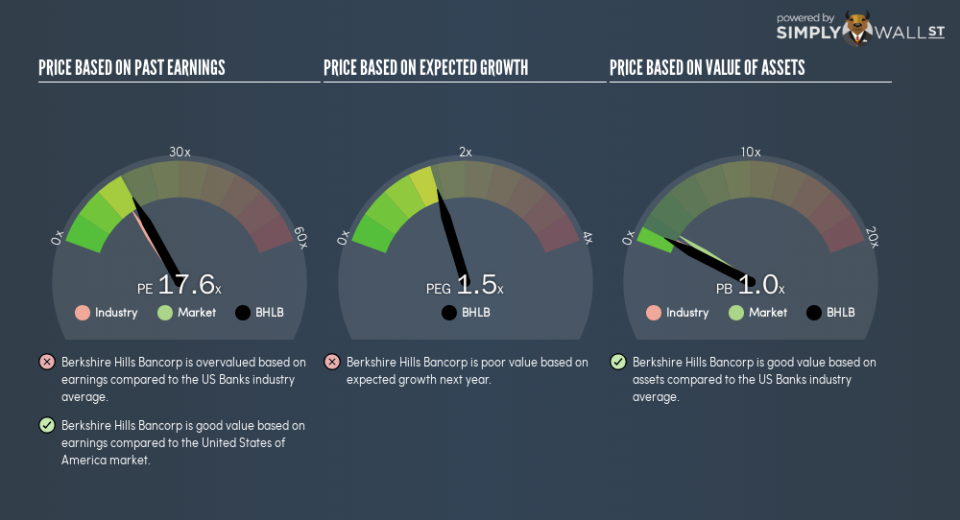Here’s What Berkshire Hills Bancorp Inc’s (NYSE:BHLB) P/E Is Telling Us

This article is written for those who want to get better at using price to earnings ratios (P/E ratios). We’ll look at Berkshire Hills Bancorp Inc’s (NYSE:BHLB) P/E ratio and reflect on what it tells us about the company’s share price. Based on the last twelve months, Berkshire Hills Bancorp’s P/E ratio is 17.6. That is equivalent to an earnings yield of about 5.7%.
Check out our latest analysis for Berkshire Hills Bancorp
How Do I Calculate A Price To Earnings Ratio?
The formula for P/E is:
Price to Earnings Ratio = Share Price ÷ Earnings per Share (EPS)
Or for Berkshire Hills Bancorp:
P/E of 17.6 = $33.74 ÷ $1.92 (Based on the year to September 2018.)
Is A High Price-to-Earnings Ratio Good?
A higher P/E ratio implies that investors pay a higher price for the earning power of the business. That isn’t a good or a bad thing on its own, but a high P/E means that buyers have a higher opinion of the business’s prospects, relative to stocks with a lower P/E.
How Growth Rates Impact P/E Ratios
Companies that shrink earnings per share quickly will rapidly decrease the ‘E’ in the equation. That means even if the current P/E is low, it will increase over time if the share price stays flat. Then, a higher P/E might scare off shareholders, pushing the share price down.
Berkshire Hills Bancorp’s earnings per share were pretty steady over the last year. But EPS is up 5.0% over the last 5 years. And over the longer term (3 years) earnings per share have decreased 2.8% annually. So we might expect a relatively low P/E.
How Does Berkshire Hills Bancorp’s P/E Ratio Compare To Its Peers?
We can get an indication of market expectations by looking at the P/E ratio. The image below shows that Berkshire Hills Bancorp has a higher P/E than the average (15.7) P/E for companies in the banks industry.
Berkshire Hills Bancorp’s P/E tells us that market participants think the company will perform better than its industry peers, going forward. Clearly the market expects growth, but it isn’t guaranteed. So further research is always essential. I often monitor director buying and selling.
Don’t Forget: The P/E Does Not Account For Debt or Bank Deposits
Don’t forget that the P/E ratio considers market capitalization. Thus, the metric does not reflect cash or debt held by the company. Theoretically, a business can improve its earnings (and produce a lower P/E in the future), by taking on debt (or spending its remaining cash).
Such expenditure might be good or bad, in the long term, but the point here is that the balance sheet is not reflected by this ratio.
How Does Berkshire Hills Bancorp’s Debt Impact Its P/E Ratio?
Berkshire Hills Bancorp has net debt worth 91% of its market capitalization. This is a reasonably significant level of debt — all else being equal you’d expect a much lower P/E than if it had net cash.
The Bottom Line On Berkshire Hills Bancorp’s P/E Ratio
Berkshire Hills Bancorp has a P/E of 17.6. That’s around the same as the average in the US market, which is 17.9. While it does have considerable debt, the market seems to be reassured by recent growth in earnings per share.
When the market is wrong about a stock, it gives savvy investors an opportunity. If it is underestimating a company, investors can make money by buying and holding the shares until the market corrects itself. So this free visualization of the analyst consensus on future earnings could help you make the right decision about whether to buy, sell, or hold.
But note: Berkshire Hills Bancorp may not be the best stock to buy. So take a peek at this free list of interesting companies with strong recent earnings growth (and a P/E ratio below 20).
To help readers see past the short term volatility of the financial market, we aim to bring you a long-term focused research analysis purely driven by fundamental data. Note that our analysis does not factor in the latest price-sensitive company announcements.
The author is an independent contributor and at the time of publication had no position in the stocks mentioned. For errors that warrant correction please contact the editor at editorial-team@simplywallst.com.

